
A minute of arc, arcminute (arcmin), arc minute, or minute arc, denoted by the symbol ′, is a unit of angular measurement equal to 1/60 of one degree. Since one degree is 1/360 of a turn, or complete rotation, one arcminute is 1/21600 of a turn. The nautical mile (nmi) was originally defined as the arc length of a minute of latitude on a spherical Earth, so the actual Earth circumference is very near 21600 nmi. A minute of arc is π/10800 of a radian.
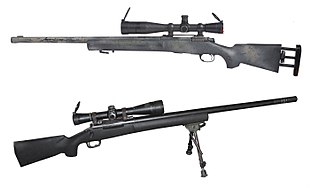
A sniper rifle is a high-precision, long-range rifle. Requirements include high accuracy, reliability, and mobility, concealment, and optics, for anti-personnel, anti-materiel and surveillance uses by military snipers. The modern sniper rifle is a portable shoulder-fired rifle with either a bolt action or semi-automatic action, fitted with a telescopic sight for extreme accuracy and chambered for a high-ballistic performance centerfire cartridge.

External ballistics or exterior ballistics is the part of ballistics that deals with the behavior of a projectile in flight. The projectile may be powered or un-powered, guided or unguided, spin or fin stabilized, flying through an atmosphere or in the vacuum of space, but most certainly flying under the influence of a gravitational field.

A reticle, or reticule also known as a graticule, is a pattern of fine lines or markings built into the eyepiece of an optical device such as a telescopic sight, spotting scope, theodolite, optical microscope or the screen of an oscilloscope, to provide measurement references during visual inspections. Today, engraved lines or embedded fibers may be replaced by a digital image superimposed on a screen or eyepiece. Both terms may be used to describe any set of patterns used for aiding visual measurements and calibrations, but in modern use reticle is most commonly used for weapon sights, while graticule is more widely used for non-weapon measuring instruments such as oscilloscope display, astronomic telescopes, microscopes and slides, surveying instruments and other similar devices.
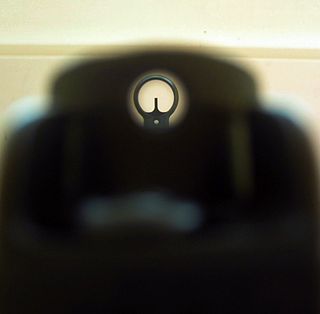
Iron sights are a system of physical alignment markers used as a sighting device to assist the accurate aiming of ranged weapons (such as a firearms, airguns, crossbows, and bows, or less commonly as a primitive finder sight for optical telescopes. Iron sights are the earliest type of sighting device, as it relies completely on the viewer's naked eye, and is distinctly different to optical sights such as telescopic sights, reflector sights, holographic sights, and laser sights, which make use of optical manipulation and/or active illumination.
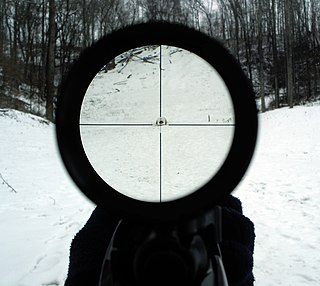
A telescopic sight, commonly called a scope informally, is an optical sighting device based on a refracting telescope. It is equipped with some form of a referencing pattern – known as a reticle – mounted in a focally appropriate position in its optical system to provide an accurate point of aim. Telescopic sights are used with all types of systems that require magnification in addition to reliable visual aiming, as opposed to non-magnifying iron sights, reflector (reflex) sights, holographic sights or laser sights, and are most commonly found on long-barrel firearms, particularly rifles, usually via a scope mount. Similar devices are also found on other platforms such as artillery, tanks and even aircraft. The optical components may be combined with optoelectronics to add night vision or smart device features.
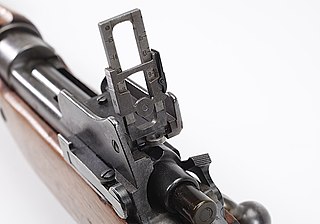
Point-blank range is any distance over which a certain firearm or gun can hit a target without the need to elevate the barrel to compensate for bullet drop, i.e. the gun can be pointed horizontally at the target. For targets beyond-blank range, the shooter will have to point the barrel of their firearm at a position above the target, and firearms that are designed for long range firefights usually have adjustable sights to help the shooter hit targets beyond point-blank range. The maximum point-blank range of a firearm will depend on a variety of factors such as muzzle velocity and the size of the target.

A shooting range, firing range, gun range or shooting ground is a specialized facility, venue, or field designed specifically for firearm usage qualifications, training, practice, or competitions. Some shooting ranges are operated by military or law enforcement agencies, though the majority of ranges are privately owned by civilians and sporting clubs and cater mostly to recreational shooters. Each facility is typically overseen by one or more supervisory personnel, known as a Range Officer (RO), or sometimes a range master in the United States. Supervisory personnel are responsible for ensuring that all safety rules and relevant laws are followed at all times.
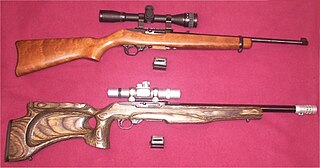
Accurizing is the process of improving the accuracy and precision of a gun.

A milliradian is an SI derived unit for angular measurement which is defined as a thousandth of a radian (0.001 radian). Milliradians are used in adjustment of firearm sights by adjusting the angle of the sight compared to the barrel. Milliradians are also used for comparing shot groupings, or to compare the difficulty of hitting different sized shooting targets at different distances. When using a scope with both mrad adjustment and a reticle with mrad markings, the shooter can use the reticle as a ruler to count the number of mrads a shot was off-target, which directly translates to the sight adjustment needed to hit the target with a follow-up shot. Optics with mrad markings in the reticle can also be used to make a range estimation of a known size target, or vice versa, to determine a target size if the distance is known, a practice called "milling".

Boresighting is a method of visually pre-aligning a firearm barrel's bore axis with the target, in order to more easily zero the gunsight. The process is usually performed on a rifle, and can be accomplished either with the naked eye, or with a specialized device called a boresighter.

Benchrest shooting is a shooting sport discipline in which high-precision rifles are rested on a table or bench – rather than being carried in the shooter's hands – while shooting at paper or steel targets, hence the name "benchrest". Both the forearm and buttstock of such a rifle are usually fully supported by bean bags, a bipod/monopod (front/rear) combination, and/or a specially designed fixture device called shooting rest, so that the gun can remain stably pointing at the target without needing to be held by someone. When shooting, the shooter simply sits/stands comfortably behind the table/bench, operates the action and pulls the trigger, without needing to worry about carrying any weight of the gun. This is in contrast to other shooting disciplines, where the shooter has to bear at least part of the gun's weight while holding it steady to aim, even when using support devices such as bipods, tripods or shooting sticks.
The Karabiner Modell 1931 is a magazine-fed, straight-pull bolt-action rifle. It was the standard-issue rifle of the Swiss armed forces from 1933 until 1958 though examples remained in service into the 1970s. It has a 6-round removable magazine, and is chambered for the 7.5×55mm Swiss Gewehrpatrone 1911 or GP 11, a cartridge with ballistic qualities similar to the 7.62×51mm NATO/.308 Winchester cartridge. Each rifle included a 6-round detachable box magazine with matching stamped serial number. A stripper clip can be used to load the magazine from the top of the receiver.

The Zastava M76 is a military semi-automatic designated marksman rifle developed and manufactured by Zastava Arms.

Field target is an outdoor airgun field shooting sport. Competitions are usually fired at self indicating steel targets placed between 9 and 50 m. There are two classes; Piston for spring-piston air guns, and PCP for pre-charged pneumatic air guns. In sanctioned competitions, the same competition rule set is used around most of the world. A small match can consist of 40 to 60 rounds, while the world championship consists of 150 rounds. It is common to use scope sights with high magnification and a short depth of field such that an adjustable parallax knob can be used to precisely determine the target distance. The target kill zones have three standardised sizes, which are 15 mm, 25 mm or 40 mm.
The following are terms related to firearms and ammunition topics.

The PSO-1 is a 4×24 telescopic sight manufactured in Russia by the Novosibirsk instrument-making factory and issued with the Russian military Dragunov sniper rifle. It was introduced on 3 July 1963 together with the Dragunov sniper rifle.

A red dot sight is a common classification for a non-magnifying reflector sight that provides an illuminated red dot to the user as a point of aim. A standard design uses a red light-emitting diode (LED) at the focus of collimating optics, which generates a dot-style illuminated reticle that stays in alignment with the firearm the sight is attached to, regardless of eye position.

Long range shooting is a collective term for shooting disciplines where the distance to target is significant enough that shooter has to put effort into calculating various ballistic factors, especially in regards to the deviating effects of gravity and wind. While shooting at shorter ranges, a shooter only has to slightly adjust the sights to compensate for limited bullet drop at most, but when the range is extended, wind drift will be the first factor affecting precision to the extent that it must be taken into serious account. Some would argue that long range shooting starts where assessment of wind, distance and various atmospheric conditions are equally important for the results as pure shooting skills - meaning that even if one conducts a technically perfect shot, the shooter will miss the target because of incorrect calculations, neglecting to take some elements into consideration, or merely due to unpredictable downrange conditions. It is widely accepted within interdisciplinary circles that for a standard rifle firing full-powered cartridges, "long range" means the target is more than 600 m (660 yd) away,, while "extreme long range" is generally accepted as when the target distance is more than 1,000 m (1,100 yd) away from the shooter.
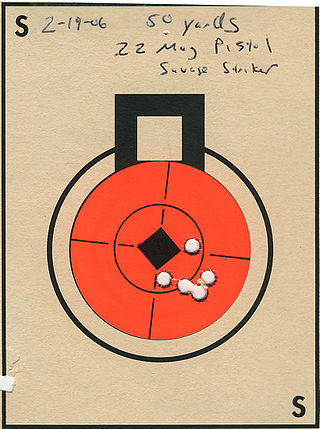
In shooting sports, a shot grouping, or simply group, is the collective pattern of projectile impacts on a target from multiple consecutive shots taken in one shooting session. The tightness of the grouping is a measure of the precision of a weapon, and a measure of the shooter's consistency and skill. On the other hand, the grouping displacement is a measure of accuracy.























